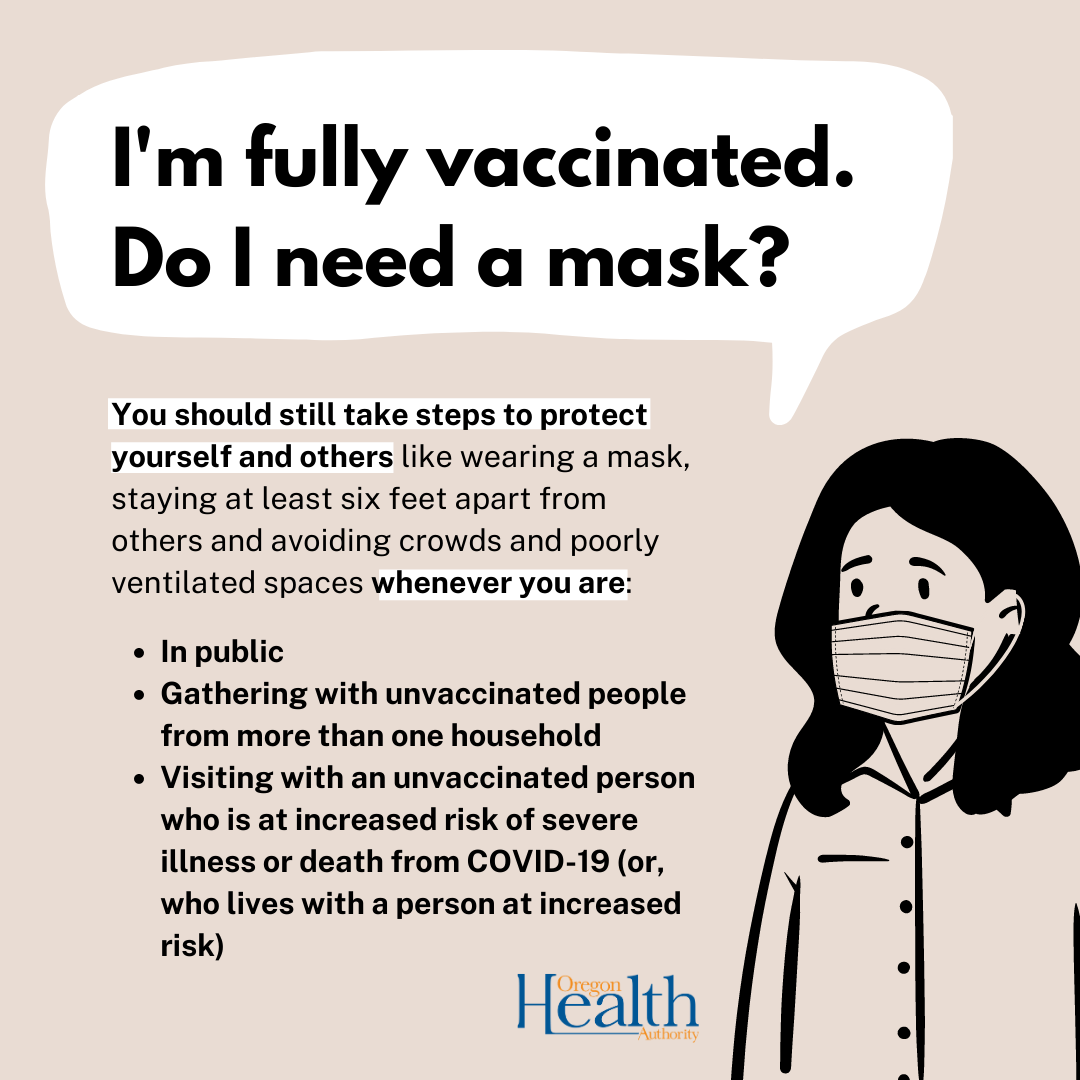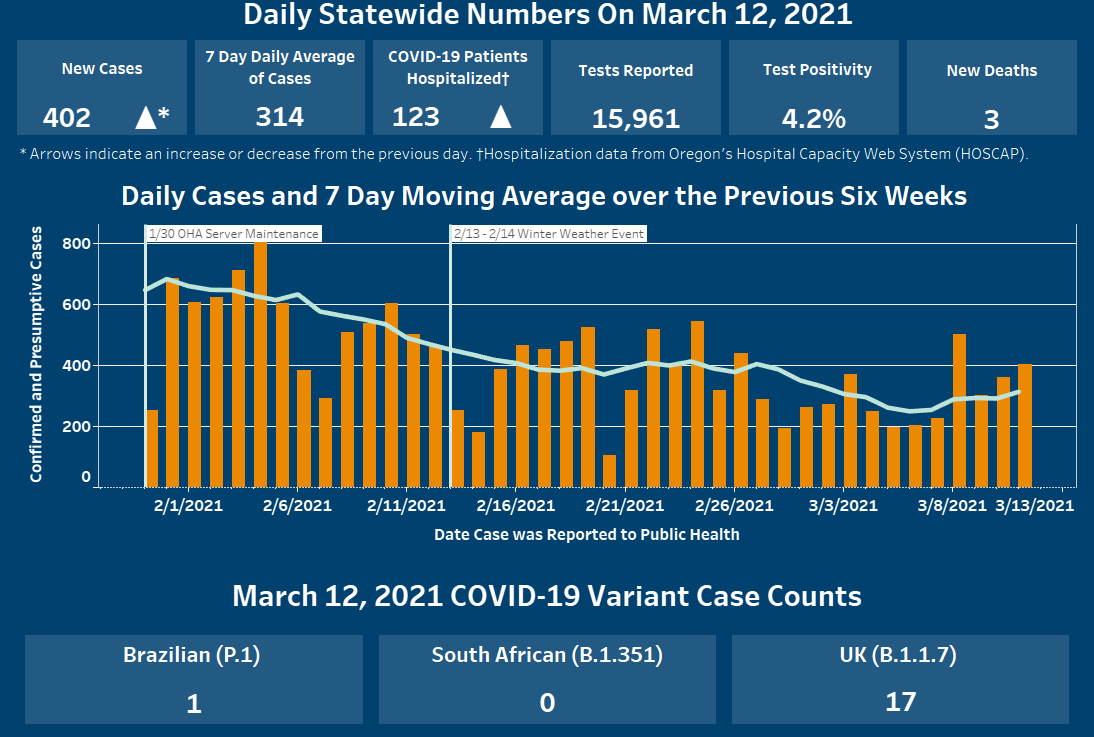There are three new COVID-19 related deaths in Oregon, raising the state’s death toll to 2,319, the Oregon Health Authority reported Friday March 12, 2021.
OHA also reported 402 new confirmed and presumptive cases of COVID-19, bringing the state total to 159,037.
The new confirmed and presumptive COVID-19 cases reported are in the following counties: Baker (3), Benton (18), Clackamas (49), Clatsop (2), Columbia (2), Coos (21), Crook (1), Curry (5), Deschutes (8), Douglas (19), Grant (4), Hood River (1), Jackson (24), Jefferson (2), Josephine (25), Klamath (11), Lake (2), Lane (14), Lincoln (5), Linn (12), Malheur (1), Marion (34), Multnomah (73), Polk (8), Tillamook (5), Umatilla (3), Union (4), Washington (41) and Yamhill (5).
Good news on vaccine allocation & COVID-19 trends, update on new mutations
OHA responds to President Biden’s vaccine eligibility announcement
At a news conference today, Oregon Health Authority (OHA) Director Patrick Allen addressed President Biden’s March 11 exciting announcement directing states to open vaccine eligibility to all adults by May 1.
“We appreciate the administration’s commitment to delivering enough vaccine to meet the President’s goal,” he said. Allen wants Oregonians to know:
- Oregon is ready: Oregon’s vaccinators have the capacity to double the current average number of doses administered per day, which is about 24,000 today.
- Oregon is on track with our current eligibility timelines, which we set based on our current allocations. We’ve been clear we want to advance our timelines, and we can move them up, if we receive enough doses from the federal government.
- But we need to know when more vaccine will arrive in Oregon before we can tell a frontline worker or anyone else that we’re adjusting our timelines. Therefore, until we get more clarity, we need to keep our current timelines in place. We will provide updates as we learn more.
Oregon’s recent COVID-19 trends
At the press conference, State Epidemiologist Dr. Dean Sidelinger reported on Oregon’s general trend of declining daily COVID-19 cases, hospitalizations and the percent of positive test results.
- Just 10 weeks ago – as 2021 began – our seven-day rolling average of new cases was 1,149. As of yesterday, the seven-day rolling average was 295, a 74% decline.
- In our most recent weekly report, for the week from March 1 through March 7, OHA reported 1,729 cases, a 35% decrease from the previous week.
- COVID-19 hospitalizations are also trending dramatically lower. On Jan. 2, OHA reported 466 COVID-19 patients in our hospitals. Yesterday there were 121, a 74% decline.
- Last week, we reported the lowest weekly total of COVID-19 patients in five months.
- The percentage of positive tests has also dropped – to 2.8%, which is the lowest since our change to a test-based testing method in mid-November.
- COVID-19 associated deaths have also fallen from their peaks in December.
- Just a month ago, 27 of Oregon’s 36 counties were classified as extreme or high risk from spread of COVID-19. Today there are 11, and only two are considered at extreme risk. This means 25 counties are at moderate or lower risk.
“All of this is really encouraging news,” Dr. Sidelinger said. “It’s a testament to our collective efforts to control the spread of the virus. And I say thank you Oregonians.”
Today, the latest COVID-19 forecast was released as well. You can learn more in the daily news release.
Learning more about mutations
Though there was a lot of encouraging news today, we were reminded to stay vigilant: COVID-19 has not been eliminated in Oregon.
Dr. Renee Edwards, the chief medical officer for OHSU Health, discussed COVID-19 variants.
She noted that earlier this month two concerning variants – those prevalent in Brazil and California – were found from COVID-19 test samples taken in Douglas and Lane Counties. And this week, researchers at the Oregon SARS-CoV-2 Genome Sequencing Center at OHSU have detected a novel virus variant, never before detected in the United States, right here in our own backyard. This variant contains characteristics of both the B.1.1.7 strain – that first found in the United Kingdom – and a newer virus mutation known as E484K – or “Eek” – that is currently circulating in both Brazil and South Africa.
So, what does this all mean? There is still a lot to learn about how these new variants may impact Oregonians. More investigation is necessary to better understand how prevalent they are here, if they increase severity of illness or whether they may infect a vaccinated person.
However, we do know that viruses like SARS-CoV-2, the virus that causes COVID-19, constantly change. It is a common part of a virus’ life cycle, which is why are we hearing of so many variants. This also means that we will continue to see new mutations and variants emerge through the rest of the pandemic.
Dr. Edwards reminded us that not all virus mutations are troublesome. While some may become more persistent or contagious, others may not affect disease severity or how fast they spread.
This is why it is important that we continue to identify, monitor and report any signs of new virus variants that may result in Oregon, or across the globe.
Edwards also had some good news to share: “We are encouraged that the currently available COVID-19 vaccines appear to be effective in preventing severe illness and death in virus variants of concern, including those here in Oregon.”
You can see a recording of the press conference in English or Spanish.
![]()
New guidance for the ‘fully vaccinated’
The Centers for Disease Control and Prevention (CDC) has new guidance for people who are fully vaccinated. People are considered fully vaccinated:
- Two weeks after their second dose in a two-dose series, like the Pfizer or Moderna vaccines, or
- Two weeks after a single-dose vaccine, like the Johnson & Johnson vaccine
In non-healthcare settings, there are some things you can do if you are fully vaccinated:
- Visit with other fully vaccinated people indoors without wearing masks or physical distancing
- Visit with unvaccinated people from a single household who are at low risk for severe COVID-19 disease indoors without wearing masks or physical distancing
If you are fully vaccinated, you should still take steps to protect yourself and others in many situations, like wearing a mask, staying at least 6 feet apart from others, and avoiding crowds and poorly ventilated spaces. Take these precautions whenever you are:
- In public
- Gathering with unvaccinated people from more than one other household
- Visiting with an unvaccinated person who is at increased risk of severe illness or death from COVID-19 or who lives with a person at increased risk
It’s also important to get tested if you have COVID-19 symptoms, follow guidance issued by individual employers, and follow CDC and health department travel requirements and recommendations.
OHA has updated its face covering guidance, gathering guidance and travel recommendations to align with these changes.

Vaccinations in Oregon
Today, OHA reported that 34,613 new doses of COVID-19 vaccinations were added to the state immunization registry. Of this total, 23,075 doses were administered on March 11 and 11,538 were administered on previous days but were entered into the vaccine registry on March 11. Cumulative daily totals can take several days to finalize.
Oregon has now administered a cumulative total of 1,269,595 first and second doses of COVID-19 vaccines. To date, 1,567,515 doses of vaccine have been delivered to sites across Oregon.
These data are preliminary and subject to change. OHA‘s dashboards provide regularly updated vaccination data, and Oregon’s dashboard has been updated today.
COVID-19 hospitalizations
The number of hospitalized patients with COVID-19 across Oregon is 123, which is two more than yesterday. There are 23 COVID-19 patients in intensive care unit (ICU) beds, which is one fewer than yesterday. The total number of patients in hospital beds may fluctuate between report times. The numbers do not reflect admissions per day, nor the length of hospital stay. Staffing limitations are not captured in this data and may further limit bed capacity. More information about hospital capacity can be found here.
Learn more about COVID-19 vaccinations
To learn more about the COVID-19 vaccine situation in Oregon, visit our webpage (English or Spanish), which has a breakdown of distribution and other information.


